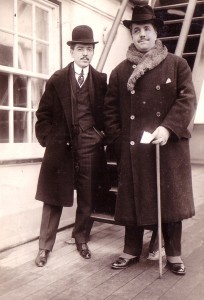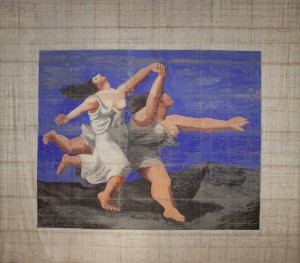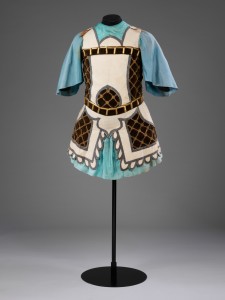On a recent visit to Washington, DC, I spent several leisurely hours at the wonderful multi-media exhibition at The National Gallery of Art, “Diaghilev and The Ballet Russes, 1909-1929: when Art Danced with Music” which is now on view until September 2, 2013. If your summer travels take you to DC and you enjoy dance, art, ballet, music or European history don’t miss it! Admission to the museum is free but buy the $5 audio tour which is well worth it and take the time to see the film narrated by the actress Tilda Swinton.
This trailblazing ballet company was founded by Russian impresario Serge Diaghilev in Paris in 1909. Below is an image of a 1923 poster designed for the company.

lithograph
framed: 90.5 x 130 cm (35 5/8 x 51 3/16 in.)
V&A, London
I strolled leisurely through each room watching the different film clips of the legendary ballets that were interspersed between the beautiful sculptures, intricate costumes, artwork and original scenery on display.

photograph by Bain News Service
10.16 × 15.24 cm (4 × 6 in.)
Collection of Ms. Anna and Mr. Leonid Winestein
Mr. Serge Diaghilev’s (he is the man with the scarf in the photograph) zeal and innate PR savvy helped foster the notoriety of his company in Europe, the U.S. and South America.
Below are four strategies that worked for him a century ago and are still relevant for marketers and marketing communications practitioners today.
1. HARNESS INFLUENCERS
Without the help of 21st century social-media marketing tools, Diaghilev tactfully encouraged contemporary artists of his time such as Henri Matisse, Pablo Picasso, Leon Bakst and several others to design costumes and scenery. He tapped composers like Igor Stravinsky and Erik Satie to write the musical scores. With uncanny foresight and intuition Diaghilev understood the value of collaborating with these talented artists.
Diaghilev personally visited Matisse to convince the artist to move beyond his comfort zone and design costumes for his ballets one of which was “The Song of the Nightingale.” Picasso’s cubist influence is evident in the costumes for “Parade.” The front cloth for “Le Train Bleu” (The Blue Train) adorned with two large voluptuous figures was based on a Picasso painting as seen in the image below.

Front cloth for The Blue Train, 1924
oil on canvas
overall: 1040 x 1172 cm (409 7/16 x 461 7/16 in.)
V&A, London
© 2013 Estate of Pablo Picasso/Artists Rights Society (ARS), New York
2. CREATE WORD OF MOUTH
The “Rite of Spring,” choreographed by Vaslav Nijinsky, (also a star dancer of The Ballet Russes) is now celebrating its 100 anniversary but at the time it was groundbreaking causing an uproar among Parisian audiences. Unlike traditional performances danced by graceful ballerinas with pointed feet, these dancers landed flat-footed with unusual stomping movements often resembling modern dancers of today. The costumes sported bold, colorful geometrical designs.
The “Rite of Spring” ultimately gained widespread popularity in large part because it was so atypical and word spread of this “must see it to believe it” ballet.

Costume for a Warrior from The Song of the Nightingale, 1920
felt, velvet, satin and silk with paint, gold tinsel, studs and braid, and brass decorations
overall: 155 x 75 x 60 cm (61 x 29 1/2 x 23 5/8 in.)
V&A, London
3. BE INNOVATIVE
Diaghilev didn’t follow the crowd. Many of his ballets such as “Le Train Bleu” were revolutionary. Unlike the tutu wearing ballerinas often seen back then, the dancers in “Le Train Bleu” set in a French resort, conveyed leisure activities by simulating summer sports like swimming and tennis and athletic gymnastics-like movements. They wore modern, form fitting knitted costumes designed by Coco Chanel resembling the kind of outfits you might see worn by fitness buffs today.
The costume designed by Henri Matisse for “The Song of the Nightingale” with its color and artful design is unlike those normally worn by ballerinas in the early 1900’s.
4. RELATE TO YOUR AUDIENCE
The timeless theme of redemption is prominent in “The Prodigal Son” the emotional ballet choreographed by Diaghilev’s last choreographer George Balanchine. The film clip in the exhibition portrays a young Mikhail Baryshnikov in the leading role. Stories of personal redemption are as popular now as they were in Diaghilev’s time and still resonate with audiences worldwide.
————-
This exhibition has generated a lot of media coverage. To read or listen to Susan Stamberg’s report for NPR “Modern Movement: How the Ballet Russes Revolutionized Dance” click here.
My special thanks to the press office of the National Gallery of Art for supplying the lovely photos.